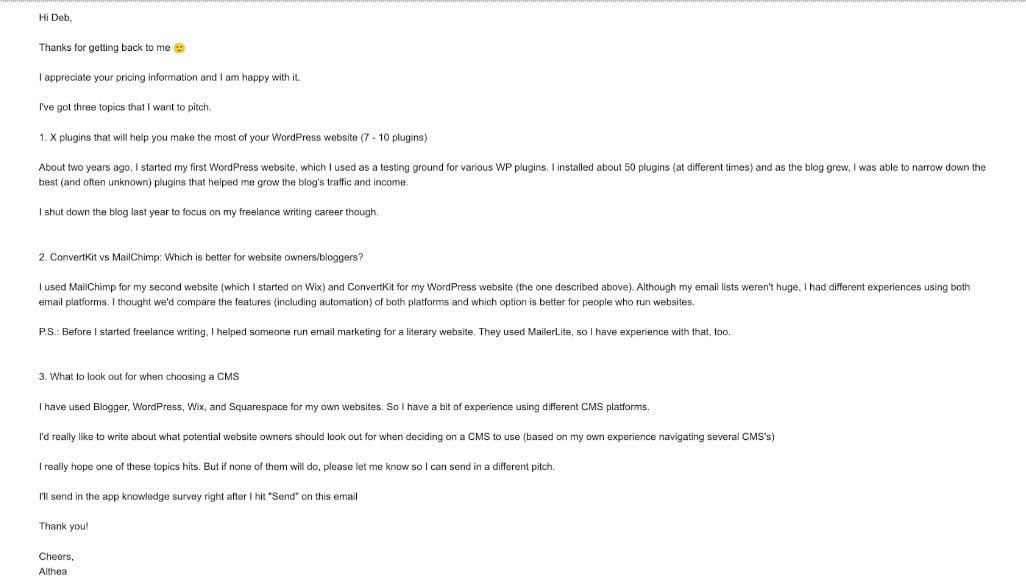A major part of any PR strategy is pitching interesting stories to the right reporters. Without sending pitches, your story likely won’t get noticed, covered, or shared. It can be tricky, however, to write a media pitch that will pique a reporter’s interest in your story and compel them to cover it.
Read on to learn some best practices you can employ when writing media pitches, and some examples of real-life media pitches to inspire your own.
A typical media pitch contains important details that can grab the recipient’s attention, including:
- The lede: This is a captivating opening sentence that shows why your story is interesting and newsworthy.
- The intent: This part is where you tell the reporter what you want them to do with your story. Do you want them to write a review, conduct an interview, or use your data/research in an existing story?
- The value proposition: This part explains why the reporter should be interested in your story. Some reasons could be that it has original data, reliable sources, or interesting physical cases.
Best practices in writing a media pitch
No matter the industry you represent, knowing how to craft an effective media pitch is the most critical part of a solid PR strategy. Here are some valuable tips that will help you up your media pitching game in no time:
1. Ensure that your story is newsworthy
The media thrives off stories that are trendy, shocking, or engaging — or all of the above. So before pitching a story, make sure it meets these criteria. Ask yourself:
- Is this story new/current?
- Does this story induce an emotional response?
- Will this story have an impact on people?
If you answer “yes” to these questions, there’s a chance that a reporter will be interested in covering your story.
2. Pitch relevant media contacts
In the media, journalists and reporters have their own specialties. They’re called ‘beats’ and refer to the types of stories the reporter covers. Before you pitch, make a list of reporters whose beats match your story.
If your story doesn’t match a reporter’s beat, they won’t cover it no matter how genius it is. In fact, it will reflect poorly on you as the reporter might interpret it to mean that you’re sending mass emails without first doing the research.
3. Write a strong subject line
Your subject line is the first thing a reporter sees when they receive your email, and it influences their decision to open it. Your story can be solid, but if the reporter doesn’t read your pitch, the quality won’t matter.
So pay attention to your subject line. Keep it brief—say just enough to pique the reporter’s interest. You can use shocking stats, thought-provoking questions, or even contrarian ideas in your subject line to grab attention.
If you’re not sure how to construct your subject line, check out the headlines of some articles that the reporter has published to get a sense of their style. Then try to replicate that.
4. Personalize your pitch
To get a reporter invested in your pitch, craft it like you’re talking directly to them. Avoid a generic pitch you can copy, paste, and send to dozens of reporters at a time.
Take the time to find the reporter’s personal/work email and, in your pitch, discuss a recently published story or major achievement of theirs. A personalized email signals that you did your research before pitching.
Pro tip: Establishing a relationship with the reporter via social media increases your chances of them reading your pitch.
5. Keep your pitch brief
Reporters often receive dozens, if not hundreds, of media pitches every day, so they don’t have time to read and respond to lengthy pitches.
To get a better chance of a response, keep your brief concise. Only include important information in the pitch, and use bullet points to summarize the major points of your story. Not only is this professional, but it shows that you respect the reporter’s time.
6. Follow up in a timely manner
Reporters are busy people—they may forget to respond to your pitch even if they’re interested. That’s why you should send follow-up emails.
The rule of thumb is that you shouldn’t send more than 2-3 follow-up emails if you don’t get a reply from the media contact. Wait at least one week after your initial media pitch before sending the first follow-up email. This ensures that the reporter has enough time to go through their inbox and respond. If they don’t respond to your first follow-up email, wait a few days before sending a second and third. You should also note the importance of using automation for your follow-up emails to save you time and effort.
Pro tip: You could add a little extra information about your story in your follow-up emails, just in case the reporter is on the fence about covering it. Also, include your original pitch at the bottom of your follow-up emails to remind the recipient and provide more context.
5 media pitching examples
If you’re trying to write a media pitch, here are some great examples you can draw inspiration from:
1. Cold media pitch
This is a media pitching strategy where a PR professional sends a media pitch to a reporter they have yet to interact with before.
In this straight-to-the-point pitch, the sender provides some information about himself, the charity organization he works for, and the topic he’d like the reporter to cover.

2. Multiple-options pitch
In this pitch, a writer is sending the editor of a popular SaaS blog some ideas that may be a good fit for the blog. Notice how the writer explains why she suggested each topic, based on her own experience. This allows the editor to consider all options carefully and pick the topic they think will resonate most with their readers.
Before sending this type of pitch, go through some of the publication’s existing articles to get a feel for the topics it covers and the writing style its readers appreciate.

3. Added-value pitch
In this pitch, the sender published a new report about Livestream shopping and thought that their findings would fit well with an existing article the recipient has published. Notice how the sender noted some key insights that might interest the recipient. This is to show how valuable their report is.
This pitch can be successful if you have original data that will add value to an existing piece that the reporter has already published.

4. Product/service pitch
This media pitch highlights a new service that a vegan restaurant offers. The sender talks about this new service and mentions how it’ll benefit its customers and the readers of the publication.
This kind of pitch works best when you’ve confirmed that the people you want to reach are frequent readers of the publication you’re pitching to.

5. Follow-up pitch
In this follow-up pitch, the PR professional reminds the reporter of the media pitch they sent a week before. The sender also uses this opportunity to reintroduce the pitch, which increases the chances of the reporter reading the email. At the end of this short email, the sender restates the benefits the media outlet will receive if it covers the story.

Write irresistible media pitches
Each media pitch you send presents an opportunity for you to expand your reach and forge new relationships within the media. So while you pay close attention to the quality of your story, you shouldn’t neglect other aspects, such as the reporter you’re pitching, your subject line, the length and tone of your pitch, and your follow-up emails.
Following the best practices outlined above increases your chances of a reporter reading your pitch and covering your story in their publication. Media pitches that get accepted can help you reach a new audience, improve your reputation, and even give your business an SEO boost via link-building.
If you’re still not sure how to structure your media pitch, you can check out some email templates to get a few ideas.








